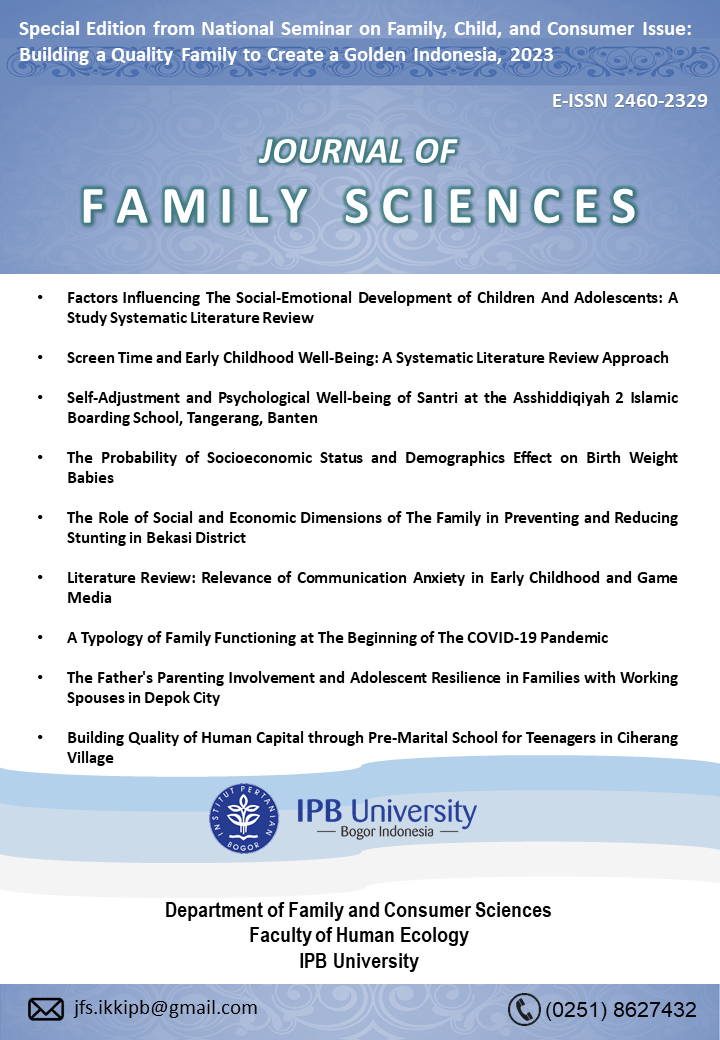The Probability of Socioeconomic Status and Demographics Effect on Birth Weight Babies
Abstract
Low Birth Weight (LBW) can lead to stunting and the impact of stunting in long term. Socioeconomic status and demographic factors can be a cause of baby’s low birth weight. The study aims to analyze the probability of a household giving birth to a baby with low birth weight. The data used in the research uses data from the 2021 National Socio-economic Survey (Susenas). The model used in this study is a logit model with a total of 2,203,472. The result shows poor households, household partners with low education, and household members who smoke have a significantly lower probability of giving birth to normal baby’s weight Meanwhile, households who work in the formal sector and live in urban areas have a significantly higher probability of giving birth to normal-weight babies. Households with a good socioeconomic status will provide optimal nutrition. Households in urban areas still have a better level of health than those in rural areas and households that do not smoke will give birth to healthier babies with normal weight.
Downloads
References
[BPS] Badan Pusat Statistik Indonesia. (2020). Klasifikasi Desa Perkotaan dan Perdesaan di Indonesia 2020. Jakarta(ID): BPS
[BPS] Badan Pusat Statistik Indonesia. (2021a). Laporan Indeks Khusus Penanganan Stunting 2019-2020. Jakarta(ID): BPS
[BPS] Badan Pusat Statistik Indonesia. (2021b). Statistik Kesejahteraan Rakyat 2021. Jakarta(ID): BPS
[BPS] Badan Pusat Statistik Indonesia. (2021c). Statistik Pendidikan 2021. Jakarta(ID): BPS
[BPS] Badan Pusat Statistik Indonesia. (2023a). Indeks Pembangunan Manusia. Badan Pusat Statistik. Jakarta(ID): BPS
[BPS] Badan Pusat Statistik Indonesia. (2023b). Pekerja Formal dan Informal Provinsi Jawa Barat 2020. Jakarta(ID): BPS
Angela, S. N. H. (2019). Hubungan status sosio ekonomi ibu dengan kejadian berat badan lahir rendah di Puskesmas La’O. Wawasan Kesehatan, 4(2), 74–80.
Anil, K. C., Basel, P. L., & Singh, S. (2020). Low birth weight and its associated risk factors: Health facility-based case-control study. PLoS ONE, 15(6 June). https://doi.org/10.1371/journal.pone.0234907
Aryastami, N. K., Shankar, A., Kusumawardani, N., Besral, B., Jahari, A. B., & Achadi, E. (2017). Low birth weight was the most dominant predictor associated with stunting among children aged 12-23 months in Indonesia. BMC Nutrition, 3(1). https://doi.org/10.1186/s40795-017-0130-x
Banderali, G., Martelli, A., Landi, M., Moretti, F., Betti, F., Radaelli, G., Lassandro, C., & Verduci, E. (2015). Short and long term health effects of parental tobacco smoking during pregnancy and lactation: A descriptive review. Journal of Translational Medicine, 13(1). https://doi.org/10.1186/s12967-015-0690-y
Ceka, A., & Murati, R. (2016). The role of parents in the education of children. Journal of Education and Practice, 7(5), 61-64.
Demelash, H., Motbainor, A., Nigatu, D., Gashaw, K., & Melese, A. (2015). Risk factors for low birth weight in Bale zone hospitals, South-East Ethiopia : A case-control study. BMC Pregnancy and Childbirth, 15(1), 1–10. https://doi.org/10.1186/s12884-015-0677-y
Fransiska, D., Sarinengsih, Y., Ts, N., & Suhartini, S. (2020). Faktor-Faktor yang Berhubungan dengan Kejadian Berat Badan Lahir Rendah (BBLR) di RSUD Soreang Kabupaten Bandung. Jurnal Ilmu Kesehatan Immanuel, 14(2). https://doi.org/10.36051/jiki.v14i2.143
Godah, M. W., Beydoun, Z., Abdul-Khalek, R. A., Safieddine, B., Khamis, A. M., & Abdulrahim, S. (2021). Maternal education and low birth weight in low- and middle-income countries: systematic review and meta-analysis. Maternal and Child Health Journal, 25(8), 1305–1315. https://doi.org/10.1007/s10995-021-03133-3
Handayat, M. N. A. (October 17, 2019). Inilah pentingnya peran anak bagi bangsa indonesia. Handayat.Com. Retrieved from https://www.handayat.com/inilah-pentingnya-peran-anak-bagi-bangsa-indonesia/
Handoyo, R. D., & Sjafi’i, A. (2008). Ekonomi sumber daya manusia. Surabaya: Universitas Airlangga.
Jornayvaz, F. R., Vollenweider, P., Bochud, M., Mooser, V., Waeber, G., & Marques-Vidal, P. (2016). Low birth weight leads to obesity, diabetes and increased leptin levels in adults: The CoLaus study. Cardiovascular Diabetology, 15(1), 1–10. https://doi.org/10.1186/s12933-016-0389-2
Kaur, S., Ng, C. M., Badon, S. E., Jalil, R. A., Maykanathan, D., Yim, H. S., & Jan Mohamed, H. J. (2019). Risk factors for low birth weight among rural and urban Malaysian women. BMC Public Health, 19. https://doi.org/10.1186/s12889-019-6864-4
Kayode, G. A., Amoakoh-Coleman, M., Akua Agyepong, I., Ansah, E., Grobbee, D. E., & Klipstein-Grobusch, K. (2014). Contextual risk factors for low birth weight: A multilevel analysis. PLoS ONE, 9(10). https://doi.org/10.1371/journal.pone.0109333
Retni, R., Margawati, A., & Widjanarko, B. (2017). Pengaruh status gizi & asupan gizi ibu terhadap berat bayi lahir rendah pada kehamilan usia remaja. Jurnal Gizi Indonesia (The Indonesian Journal of Nutrition), 5(1), 14-19. https://doi.org/10.14710/jgi.5.1.14-19
Meng, Y., & Groth, S. W. (2018). Fathers count: the impact of paternal risk factors on birth outcomes. Maternal and Child Health Journal, 22(3), 401–408. https://doi.org/10.1007/s10995-017-2407-8
Novita. (2022). Epidemiologi Berat Badan Lahir Rendah. Alomedika. Retieved from https://www.alomedika.com/penyakit/pediatrik-dan-neonatologi/berat-badan-lahir-rendah/epidemiologi
Pereira, P. P. D. S., Da Mata, F. A., Figueiredo, A. C. G., de Andrade, K. R. C., & Pereira, M. G. (2017). Maternal active smoking during pregnancy and low birth weight in the Americas: a systematic review and meta-analysis. Nicotine & Tobacco Research, 19(5), 497-505. https://doi.org/10.1093/ntr/ntw228
Piketty, T., Saez, E., Zucman, G., Duflo, E., & Banerjee, A. (2022). Inequality Report 2022.
Pramono, M. S., & Paramita, A. (2015). Pola kejadian dan determinanbayi dengan berat badan lahir rendah (BBLR) di Indonesia tahun 2013 (Pattern of Occurrence and Determinants of Baby with Low Birth Weight in Indonesia 2013). Buletin Penelitian Sistem Kesehatan, 18(1), 1-10. https://doi.org/10.22435/hsr.v18i1.4263.1-10
Shapiro, G. D., Bushnik, T., Sheppard, A. J., Kramer, M. S., Kaufman, J. S., & Yang, S. (2017). Paternal education and adverse birth outcomes in Canada. J Epidemiol Community Health, 71(1), 67-72. https://doi.org/10.1136/jech
Sharma, S. R., Giri, S., Timalsina, U., Bhandari, S. S., Basyal, B., Wagle, K., & Shrestha, L. (2015). Low birth weight at term and its determinants in a tertiary hospital of nepal:A case-control study. PLoS ONE, 10(4), 1–10. https://doi.org/10.1371/journal.pone.0123962
Tsuboi, H., Hirai, H., & Kondo, K. (2016). Giving social support to outside family may be a desirable buffer against depressive symptoms in community-dwelling older adults: Japan gerontological evaluation study. BioPsychoSocial Medicine, 10(1). https://doi.org/10.1186/s13030-016-0064-6
Wahyuni, D., & Fitrayuna, R. (2020). Pengaruh sosial ekonomi dengan kejadian stunting pada balita di desa kualu tambang kampar. PREPOTIF: Jurnal Kesehatan Masyarakat, 4(1), 20-26. https://doi.org/10.31004/prepotif.v4i1.539
World Health Organization. (2022). Tobacco. Jenewa(SUI): World Health Organization.
Wulandari, T. (January 3, 2023). Bayi prematur dan BBLR lebih tinggi risiko mengalami stunting. siaran pers. Retrieved from https://www.bkkbn.go.id/berita-bayi-prematur-dan-bblr-lebih-tinggi-risiko-mengalami-stunting
Authors who publish with this journal agree to the following terms:
- Authors retain copyright and grant the journal right of first publication with the work simultaneously licensed under

This work is licensed under a Creative Commons Attribution 4.0 International License. that allows others to share the work with an acknowledgement of the work's authorship and initial publication in this journal. - Authors are able to enter into separate, additional contractual arrangements for the non-exclusive distribution of the journal's published version of the work (e.g., post it to an institutional repository or publish it in a book), with an acknowledgement of its initial publication in this journal.
- Authors are permitted and encouraged to post their work online (e.g., in institutional repositories or on their website) prior to and during the submission process, as it can lead to productive exchanges, as well as earlier and greater citation of published work (See The Effect of Open Access).



_001.png)



